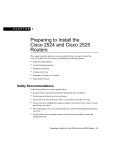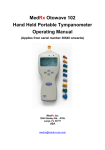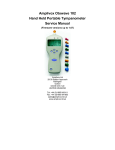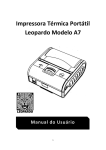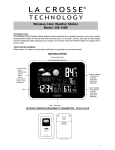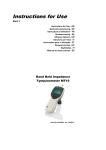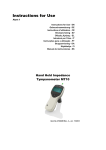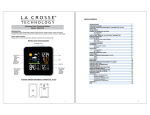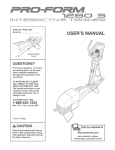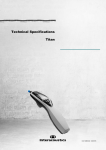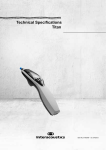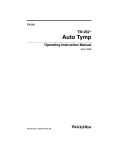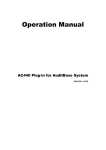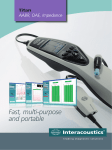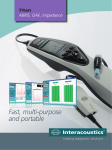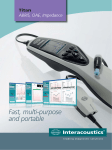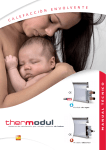Download Instructions for Use
Transcript
Instructions for Use - GB Hand Held Impedance Tympanometer MT10 Table of Contents 1. Introduction ................................................................................................................. 1 1.1 1.2 1.3 1.4 2. Unpacking and Installation ......................................................................................... 3 2.1 2.2 2.2 2.3. 3. Installing & replacing batteries ........................................................................................................... 5 Controls and indicators ...................................................................................................................... 5 The Probe .......................................................................................................................................... 6 Start up and menu display ................................................................................................................. 7 MT10 – Menu Summery..................................................................................................................... 7 3.5.1 Main menu Selections .......................................................................................................... 7 3.5.2 Sub-Menu Selections ........................................................................................................... 7 Maintenance.................................................................................................................11 4.1 4.2 4.3 4.4 4.5 4.6 5. Unpacking and Inspection .................................................................................................................. 3 Safety Regulations ............................................................................................................................. 3 Marking .............................................................................................................................................. 4 Connections ....................................................................................................................................... 4 Operating instructions ................................................................................................ 5 3.1 3.2 3.3 3.4 3.5 4. About this Manual .............................................................................................................................. 1 Intended Use ...................................................................................................................................... 1 Product Description ............................................................................................................................ 1 Warnings and Precautions ................................................................................................................. 2 General Maintenance Procedure ..................................................................................................... 11 Cleaning the Accessories ................................................................................................................. 11 Calibration and Return of the Instrument ......................................................................................... 11 How to clean Interacoustics Products .............................................................................................. 11 Concerning Repair ........................................................................................................................... 12 Warranty .......................................................................................................................................... 12 Technical Specifications.............................................................................................15 5.1 Electromagnetic Compatibility (EMC)............................................................................................... 16 Data Transfer Guide MT10 Instruction for Use - English Date: 2012-05-01 1. Page 1/16 Introduction 1.1 About this Manual This manual is valid for the hand held tympanometer MT10. Manufacturer: Manufactured for: Interacoustics A/S Drejervænget 8 DK 5610 Assens Denmark Tel.: +45 6371 3555 Fax: +45 6371 3522 E-mail: [email protected] www.interacoustics.com Web: 1.2 Intended Use The MT10 is a handheld screening tympanometer offering Tympanometry and optional Ipsi reflex testing. The MT10 allows storing of data by printing (optional printer) or by transferring data to a computer (optional software module). The MT10 tympanometer is intended to be used by an audiologist, hearing healthcare professional, or trained technician in a quiet environment (tymp and reflexes). 1.3 Product Description The MT10 is designed for use by audiologists, general practitioners, hearing aid dispensers and child health professionals. The instrument performs two types of measurement: Tympanometry is used to measure the compliance of the tympanic membrane and middle ear at a fixed frequency over a range of pressures. Optional: Reflex tests are used to measure stapedial reflexes. The MT10 measures ipsilateral reflexes and, when selected, reflex measurement is automatically carried out after a tympanogram is taken. The system includes the following included and additional parts: Included Parts MT10: 4 x 1.5V ‘AA’ Batteries 4 in 1 test cavity assembly Set of disposable ear-tips Instructions for UseCalibration certificate Warranty card Additional Parts: CAT50 Carrying case Portable thermal printer 3 rolls of thermal paper Diagnostic Suite and OtoAccess™ Infra-red USB Adapter Additional probe tip Additional sets of ear tips MT10 Instruction for Use - English Date: 2012-05-01 1.4 Page 2/16 Warnings and Precautions WARNING indicates a hazardous situation which, if not avoided, could result in death or serious injury. CAUTION, used with the safety alert symbol, indicates a hazardous situation which, if not avoided, could result in minor or moderate injury. NOTICE is used to address practices not related to personal injury 1. The instrument is not intended to be used in oxygen rich environments or use in conjunction with flammable agents. 1. The instrument is not intended to be used in environments exposed to fluid spills. 2. Ear tip are single use only. 3. Do not insert or in any way try to conduct measurements without proper probe eartip in place. 1. Be sure to insert the probe tip in a way which will assure an air tight fit without causing any harm to the patient. Using a proper and clean ear tip is mandatory. 2. Be sure to use only stimulation intensities acceptable for the patient. 3. Never clean the transducer housing with water or insertion instruments. 4. Although the instrument fulfils the relevant EMC requirements precautions should be taken to avoid unnecessary exposure to electromagnetic fields, e.g. from mobile phones etc. If the device is used adjacent to other equipment it must be observed that no mutual disturbance appears. Within the European Union it is illegal to dispose electric and electronic waste as unsorted municipal waste. Electric and electronic waste may contain hazardous substances and therefore has to be collected separately. Such products will be marked with the crossed-out wheeled bin shown below. The cooperation of the user is important in order to ensure a high level of reuse and recycling of electric and electronic waste. Failing to recycle such waste products in an appropriate way may endanger the environment and consequently the health of human beings. MT10 Instruction for Use - English Date: 2012-05-01 Page 3/16 2. Unpacking and Installation 2.1 Unpacking and Inspection Check box and contents for damage When the instrument is received please check the shipping box for rough handling and damage. If the box is damaged it should be kept until the contents of the shipment have been checked mechanically and electrically. If the instrument is faulty please contact your local distributor. Keep the shipping material for the carrier’s inspection and insurance claim. Keep carton for future shipment The MT10 comes in its own shipping carton, which is specially designed for the MT10. Please keep this carton. It will be needed if the instrument has to be returned for service. If service is required please contact your local distributor. Reporting Imperfections Inspect before connection Prior to connecting the product it should once more be inspected for damage. All of the cabinet and the accessories should be checked visually for scratches and missing parts. Report immediately any faults Any missing part or malfunction should be reported immediately to the supplier of the instrument together with the invoice, serial number, and a detailed report of the problem. In the back of this manual you will find a "Return Report" where you can describe the problem. Please use "Return Report" Please realise that if the service engineer does not know what problem to look for he may not find it, so using the Return Report will be of great help to us and is your best guarantee that the correction of the problem will be to your satisfaction. 2.2 Safety Regulations Electrical Safety: This audiometer is specified to comply with the international standard IEC 60601-1. The instrument is not intended to be used in oxygen rich environments or use in conjunction with flammable agents. MT10 Instruction for Use - English Date: 2012-05-01 Page 4/16 2.3 Marking The following marking can be found on the instrument: Symbol Explanation Type B applied parts. Patient applied parts that are not conductive and can be immediately released from the patient. Refer to instruction manual WEEE (EU-directive) This symbol indicates that when the end-user wishes to discard this product, it must be sent to separate collection facilities for recovery and recycling. The CE-mark indicates that Interacoustics A/S meets the requirements of Annex II of the Medical Device Directive 93/42/EEC. TÜV Product Service, Identification No. 0123, has approved the quality system. 0123 The number next to the symbol indicates the year of manufacture. Do not re-use Parts that are marked with this symbol are for single use only. Label to be found in the battery compartment beneath the battery. 2.4 Connections Infrared adapter (the MT10 has been tested with Actysis ACTIR2000U USB adapter and it is recommended by Interacoustics to use this device). MT10 Instruction for Use - English Date: 2012-05-01 Page 5/16 3. Operating instructions This instrument is equipped with a real-time clock. Before use, please set the date & time to local values in order to ensure that test data and calibration status are correctly identified. Careful handling of instrument whenever in contact with patient should be of high priority. Calm and stable positioning while testing is preferred for optimal accuracy. 3.1 Installing & replacing batteries The MT10 may be powered from Alkaline ‘AA’ / LR6 batteries (e.g. Duracell MN1500) or rechargeable Nickel-Metal Hydride (NiMH) batteries. Four batteries are required. If the MT10 is to be used infrequently we recommend alkaline cells are fitted. NiMH batteries have a high self-discharge rate and are likely to need recharging if left unused for several weeks. To fit the cells remove the battery compartment cover on the base of the MT10. Fit the cells as indicated inside the battery compartment. Batteries should only be changed outside the patient environment. The operator should not touch the battery connectors and the patient simultaneously. You must set which type of cell is fitted in the CONFIGURATION menu. By default this is set to ALKALINE. To change the setting select CONFIGURATION from the main menu and scroll to BATTERY TYPE as described later in this manual. A battery state indicator is shown in the top right corner of the display (except when showing test results). This shows the battery state as a progressively emptying battery. The batteries should be replaced when the symbol has an ! in front of it, or when advised to do so at switch-on. Removing the batteries does not affect the configuration, the contents of the database, the calibration settings or the results of the last test. Remove the batteries if the instruments will not be used for some time. 3.2 Controls and indicators Press the On/Off key momentarily to turn the MT10 on (refer to the diagram below). No warm-up time is required, although a short diagnostic routine will run for a few seconds. During this time the internal pump will operate. To switch off, again press the On/Off key momentarily Press the On / Off key momentarily to turn the MT10 on or off. Press the up ( - ) and down ( ¯ ) navigation keys to scroll through the menus or set values. Press the right navigation key ( ® ) to accept a menu choice or go to the next step. Press the left navigation key ( ¬ ) to cancel an operation or go back to the previous step. Infrared Window MT10 Instruction for Use - English Date: 2012-05-01 Page 6/16 Operating Language To set the operating language (English, French or German) use the options within the CONFIGURATION menu The function of the left and right keys is usually shown on the bottom line of the display. When not performing a test the MT10 will switch off automatically if no key is pressed for 90 seconds. This time can be extended to 180 seconds in the CONFIGURATION menu. The LEDs indicate the status of the system: Green LED Off On Off Yellow LED Off Off Slow flash Slow flash Off On Off Fast flash Flickering Status MT10 turned off Idle & ready to use Attempting to obtain an ear seal Taking a measurement Pump error at switch on Sending data to a PC 3.3 The Probe The small holes through the MT10 probe tip must be kept clear. If these become blocked a warning message will be displayed. The tip must be removed and cleaned or replaced. To remove the tip, unscrew the nose cone and pull the tip off the probe boss. A small seal will be found in the base of the probe tip. This should be examined and replaced if it is damaged. When replacing the tip, ensure that the seal is correctly inserted with its flat aligned with the flat on the probe tip. Push the probe tip over the boss and replace the nose cone. Make sure that the nose cone is screwed home firmly but do not over-tighten. Do not use any tools to tighten the nose cone. After replacing the tip a Daily Check should be carried out. MT10 Instruction for Use - English Date: 2012-05-01 Page 7/16 3.4 Start up and menu display When the MT10 is turned on the start-up screen is shown while internal tests are performed and the pump is initialised. When the start up sequence is complete the MAIN MENU is displayed: Menu items and instructions are shown in upper case text. Information and error messages are generally in lower case. 3.5 MT10 – Menu Summery 3.5.1 Main menu Selections Menu MAIN MENU Sub-Menu NEW TEST VIEW THE LAST TEST DAILY CHECK DATA MANAGEMENT CONFIGURATION SYSTEM INFORMATION 3.5.2 Sub-Menu Selections Sub-Menu NEW TEST Option SELECT EAR Choices/Description Open which ear(s) to test and start the test. A tympanogram is taken followed by reflex measurements, if selected. On-screen messages & LED’s indicate progress. Graphical display are shown automatically at the end. VIEW THE LAST TEST SELECT EAR Recalls the last stored test for the selected ear. Shows the tympanogram and reflex respones, if available. Also allows the last test to be printed, sent to a PC or saved in the internal database. DAILY CHECK DATA MANAGEMENT Shows the volume in ml measured by the probe. LIST RECORDS Lists the test results stored in the internal database. Allows individual records to be viewed, printed, sent to a PC or deleted. DELETE RECORDS Delete stored records. Select: ”ALL PRINTED RECORDS” – Delete all records that have been printed. MT10 Instruction for Use - English Date: 2012-05-01 PRINT RECORDS SEND RECORDS TO PC Page 8/16 ”ALL SENT RECORDS” – Delete all records that have been sent to a PC. ”ALL RECORDS” – Delete all records . Print stored records. Select: ”UNPRINTED RECORDS” – Print all records not previously printed. ”ALL RECORDS” – Delete all records. NOTE: It is advised not to transfer several records to the PC at the same time (Diagnostic suite) as the system is not prepared for this. If you select ”Send records to PC” and transfer “all records”/”Unsent records”, you get the message in the Diagnostic Suite view: “Overwrite data with new transferred data”? Hence, all the records will be sent to the dedicated folder on the PC and the Diagnostic Suite will ask if you want to overwrite the current data on the screen. So it is recommended to send the individual records by selecting “List records” (in “Data Management”) and select the preferred record. (NB: Remember to start Diagnostic Suite/Imp Module before transferring the record). NOTE: Please be aware that when connecting the USB IR receiver and the Sanibell II printer at the same time, the printer may start printing out nonsense data from the PC because the Infrared receivers may interfere with each other. However, it does not happen often that users will send data to their PC as well as print out the data on the wireless printer. IF the scenario occurs, please see that the two IR windows on these devices are not pointed directly at each other. CONFIGURATION TODAY’S DATE Set the internal clock date and time. REFLEX SELECTION (if your version has this feature) Select when reflexes will be measured: ”ALWAYS MEASURE” – Reflexes are always measured. ”NEVER MEASURE” – Reflexes are never measured. ”ONLY IF PEAK FOUND” – Reflexes will be measured only if MT10 detects a peak on the tympanogram. ”PROMPT TO MEASURE” – The user is asked whether to perform a reflex at the start of at each test. MT10 Instruction for Use - English Date: 2012-05-01 SYSTEM INFORMATION Page 9/16 REFLEX LEVELS Select the maximum tone level to be used for the reflex test. Set to 100 dB (with 5 dB or 10 dB steps) or 95 dB, 90 dB or 85 dB with 5 dB steps. Optional: REFLEX FREQUENCIES Choose to perform the reflex test at 1 KHz only or 500, 1000, 2000 and 4000. REFLEX THRESHOLD Select the change in compliance that determines that a reflex has been detected. Adjustable in 0.01 ml steps from 0.01 to 0.5 ml. Default 0.03 ml. REFLEX AUTO-STOP If selected, reflex measurement at each frequency stops as soon as a reflex is found. Default YES. REFLEX FILTER Select either 2 Hz or 1.5 Hz. The lower value smoothes the plot more. PRINTER Sanibel MPTII BATTERY TYPE Select Alkaline or NiMH (This effects the battery state display and low battery warning). POWER-OFF DELAY The time before the unit turns off automatically if no key is pressed. Select 90 or 180 seconds. LCD CONTRAST Change the display contrast 0-15. Default 7. EAR SEAL CHECK Select ”QUICK” or ”THOROUGH”. REPORT CAL. DATES Select ”PRINT CAL. DATES” or ”HIDE CAL.DATES”. SET DATE FORMAT Select ”DD/MM/YY” or ”MM/DD/YY” HOSPITAL NAME Allows the hospital name to be entered (this will appear at the top of the print out). DEPARTMENT Allows the department name to be entered (this will appear at the top of the print out). RELOAD DEFAULTS The options above are reset to their default values. SELECT LANGUAGE Select ”ENGLISH”, ”GERMAN” or ”FRENCH” for operating language. Shows: Battery voltage Software version Date calibrated Next calibration date Instrument serial number Current date and time. MT10 Instruction for Use - English Date: 2012-05-01 Page 10/16 MT10 Instruction for Use - English Date: 2012-05-01 Page 11/16 4 Maintenance 4.1 General Maintenance Procedure The MT10 is a precision instrument. Handle it carefully in order to ensure its continued accuracy and service. Before cleaning the instrument remove the batteries. Use a soft damp cloth and mild detergent to clean the instrument panel and case. Ensure no moisture enters the instrument. 4.2 Cleaning the Accessories Ear tips should be replaced after a single use. Handle the probe and accessories with care. The probe tip and its associated sealing washer are disposable devices.The probe tip should be checked before each ear insertion to ensure it is undamaged and that none of the tubes through it are blocked. It should be replaced if necessary. The sealing washer should be replaced if it shows signs of wear, or if a pressure leak is suspected. Important note: Do not allow moisture, condensation, fluids or debris to enter the probe. 4.3 Calibration and Return of the Instrument It is recommended that the MT10 is calibrated annually. Please contact Interacoustics for details. When returning the instrument for re-calibration, please use the original shipping packing materials. Place the instrument in a plastic bag before packing to stop dirt and dust getting into the probe. Do not return the batteries with the instrument. Calibration procedure is available in service manual which is available on request. Do not modify this equipment without authorization. Interacoustics will make available on request relevant circuit diagrams, component part lists, descriptions, calibration instructions, or other information that will assist service personnel to repair those parts of this tympanometer that are designated by the Interacoustics as repairable by service personnel. 4.4 How to clean Interacoustics Products If the surface of the instrument or parts of it are contaminated, it can be cleaned using a soft cloth moistened with a mild solution of water and dish washing cleaner or similar. The use of organic solvents and aromatic oils must be avoided. Be careful that no fluid is entering the inside of the instrument or the accessories. · Before cleaning always switch off and disconnect from the power supply · · · Use a soft cloth lightly dampened with cleaning solution to clean all exposed surfaces Do not autoclave, sterilize or immerse the instrument or accessory in any fluid Do not use hard or pointed objects to clean any part of the instrument or accessory MT10 Instruction for Use - English Date: 2012-05-01 · · · · Page 12/16 Do not let parts that have been in contact with fluids dry before cleaning Rubber ear-tips or foam ear-tips are single use components Ensure that isopropyl alcohol does not come into contact with any screens on the instruments Ensure that isopropyl alcohol does not come into contact with any silicone tubes or rubber parts Recommended cleaning and disinfection solutions: · Warm water with mild, nonabrasive cleaning solution (soap) · Normal hospital bactericides · 70% isopropyl alcohol only on hard cover surfaces Procedure · Clean the instrument by wiping outer case with a lint free cloth lightly dampened in cleaning solution. 4.5 Concerning Repair Interacoustics is only considered to be responsible for the validity of the CE marking, effects on safety, reliability and performance of the equipment if: 1. assembly operations, extensions, readjustments, modifications or repairs are carried out by authorised persons, 2. a 1 year service interval is maintained 3. the electrical installation of the relevant room complies with the appropriate requirements, and 4. the equipment is used by authorised personnel in accordance with the documentation supplied by Interacoustics. It is important that the customer (agent) fills out the RETURN REPORT every time a problem arises and sends it to Interacoustics, Drejervaenget 8, DK-5610 Assens, Denmark. This should also be done every time an instrument is returned to Interacoustics. (This of course also applies in the unthinkable worst case of death or serious deterioration to patient or user). 4.6 Warranty INTERACOUSTICS warrants that: · · The MT10 is free from defects in material and workmanship under normal use and service for a period of 24 months from the date of delivery by Interacoustics to the first purchaser. Accessories are free from defects in material and workmanship under normal use and service for a period of ninety (90) days from the date of delivery by Interacoustics to the first purchaser. If any product requires service during the applicable warranty period, the purchaser should communicate directly with the local Interacoustics service centre to determine the appropriate repair facility. Repair or replacement will be carried out at Interacoustics’ expense, subject to the terms of this warranty. The product requiring service should be returned promptly, properly packed, and postage prepaid. Loss or damage in return shipment to Interacoustics shall be at purchaser's risk. In no event shall Interacoustics be liable for any incidental, indirect or consequential damages in connection with the purchase or use of any Interacoustics product. This shall apply solely to the original purchaser. This warranty shall not apply to any subsequent owner or holder of the product. Furthermore, this warranty shall not apply to, and Interacoustics shall not be responsible for, any loss arising in connection with the purchase or use of any Interacoustics product that has been: MT10 Instruction for Use - English Date: 2012-05-01 Page 13/16 · · · repaired by anyone other than an authorized Interacoustics service representative; altered in any way so as, in Interacoustics judgement, to affect its stability or reliability; subject to misuse or negligence or accident, or which has had the serial or lot number altered, effaced or removed; or · improperly maintained or used in any manner other than in accordance with the instructions furnished by Interacoustics. This warranty is in lieu of all other warranties, express or implied, and of all other obligations or liabilities of Interacoustics, and Interacoustics does not give or grant, directly or indirectly, the authority to any representative or other person to assume on behalf of Interacoustics any other liability in connection with the sale of Interacoustics products. INTERACOUSTICS DISCLAIMS ALL OTHER WARRANTIES, EXPRESSED OR IMPLIED, INCLUDING ANY WARRANTY OF MERCHANTABILITY OR FOR FUNCTION OF FITNESS FOR A PARTICULAR PURPOSE OR APPLICATION. MT10 Instruction for Use - English Date: 2012-05-01 Page 14/16 MT10 Instruction for Use - English Date: 2012-05-01 Page 15/16 5. Technical Specifications ”The technical specifications provided here cover the general aspects of the instrument. The MT10 Tympanometer is classified as a Class II a device under Annex IX (Section 1) of the EU Medical Devices Directive. It is intended fortransient use as a screening tympanometer instrument Tympanometry Instrument type Analysis performed Probe tone levels and accuracy Pressure levels and accuracy Ear volume measurement range and accuracy Sweep speed Pressure limits (safety cutout) Number of samples stored Screening tympanometer Compliance peak level (in ml). Pressure of same; Gradient (in daPa); Ear Canal Volume (ECV) @ 200 daPa. 226Hz +/-2%; 85dB SPL +/-2dB over range 0.2ml to 5 ml. +200daPa to -400 daPa +/-10daPa or +/-10% (whichever is larger) over range. 0.2ml to 5ml +/-0.1ml or +/-5% (whichever is larger) over entire range. Typically 200-300daPa/sec; dependant on ear&cavity volume. +600 to -800daPa 100 per tympanogram Optional: Reflex measurements Measurement modes Reflex tone levels and accuracy Reflex measurement range and accuracy Number of reflex levels Reflex analysis Pressure used for reflex measurement Reflex level cut-off Reflex threshold detection Reflex tone duration Number of records stored in Patient Database Data storage Data held Display mode Ipsilateral optional 500Hz, 1kHz, 2kHz, 4kHz Frequency +/-2%, configurable over range 70dB to 100dB HL (4kHz restricted to 95dBHL) +/-2dB, referenced to 2ml calibration volume; Compensates for measured ear volume. 0.01ml to 0.5ml +/-0.01ml configurable in 0.01ml steps. Four: 100dB with 5dB or 10dB steps; 95dB, 90dB or 85dB with 5dB steps. Reflex pass/fail at each level tested; Maximum amplitude of each reflex (seen on printed report and PC report); Pressure at which reflex was performed. Pressure at Tympanogram peak, or 0daPa (Always and Prompt Before Each Test modes) Optionally, Auto-stop when reflex found. Configurable 0.01-0.50ml in 0.01ml increments. 0.6 seconds. 30 Any recording can be stored once the tympanogram is viewed. Patient Initials (A-Z, 0-9, “-“) must be entered before storage. Patient Initials, Tympanogram and Reflex graphs and analysis for Left Ear and/or Right Ear, Time and Date of recording, which ears were tested, whether or not the record has been printed and /or sent to a PC, parameters printed and/or sent to a PC, parameters used for analysis, 128 bit Globally Unique Idenfitier (GUID). Records listed in reverse chronological order (latest first), with indication of date stored as described above. Real Time Clock Time stamps Backup power supply Time and date stamp applied to all recordings, and to the last calibration date. >30 days without main batteries fitted. Languages Operating languages English, German or French Printing Supported printer Interface Information printed Sanibel MPTII. Infra-red, IrDA hardware, 9600 baud. Space for patient and clinician’s details, Tympanogram analysis parameters, Tympanogram, Reflex analysis parameters, Reflex graph, Serial Number of device, Last and Next Due Calibration dates. MT10 Instruction for Use - English Date: 2012-05-01 Page 16/16 Serial Interface to PC Interface Information sent OBEX (Object Exchange) service running on top of IrDA stack. Autoselects rate between 9600 – 115200 baud. Patient header, full left or right ear data. Power Supply Battery types Warm-up period Number of recordings from one set of cells Auto power-off delay Idle current Current while testing 4 Alkaline AA Cells or; 4 NIMH rechargeable batteries which must be larger than 2.3Ah capacity. None at room temperature. Approx. 300 (Alkaline AA) 90 or 180 seconds. 70mA 230mA Physical Display Dimensions Weight (without batteries) Weight (with batteries) Environmental Operating temperature range Operating humidity range Operating atmospheric pressure range Storage temperature range Storage humidity range Storage atmospheric pressure range 128x64 pixels / 8 lines of 21 characters 190mm long x 80mm wide x 40mm high excluding probe 225mm long including probe. 285g 380g o o +15 C - +35 C 30% to 90% RH, non-condensing 980 to 1040 mb o o -20 C to +70 C 10% to 90% RH, non-condensing 900 to 1100mb Standards conformance Safery EMC Performance CE mark IEC 60601-1 ANSI/AAMI ES60601-1, CAN-CSA C22.2 No 60601-1 IEC 60601-1-2 IEC 60645-5, Type 2 Tympanometer To the EU Medical Device Derective. 5.1 Electromagnetic Compatibility (EMC) See Appendix in English in the back of the manual. . Interacoustics A/S • Phone: +45 6371 3555 • Fax: +45 6371 3522 • [email protected] • www.interacoustics.com Data Transfer Guide – Existing Measurements 1. Launch the Database (OtoAccess™ or NOAH) 2. Select the right patient 3. Launch Diagnostic Suite (via OtoAccess™ or NOAH) 4. Select the IMP tab 5. Turn on the MT10 6. Select ”Data Management”. 7. Select “List Records”. 8. Form the list of records select the one you wish to transfer and select “send to computer”. 9. Connecting (”handshake” between MT10 and IR-receiver) 10. Data transferred to Diagnostic Suite (5 sec.) (Data/measurements shown in front view) 11. Save the Data. QM0101102 - A4 landscape, 020909 Interacoustics A/S • Phone: +45 6371 3555 • Fax: +45 6371 3522 • [email protected] • www.interacoustics.com Data Transfer Guide – After a Measurement 1. Launch the Database (OtoAccess™ or NOAH) 2. Select the right patient 3. Launch Diagnostic Suite (via OtoAccess™ or NOAH) 4. Select the IMP tab 5. Turn on the MT10 6. Select ”New Test” 7. Select ear (Left/Right/Both) 8. Process results (send to Computer (or save & send)) 9. Press ”select” when ready (point at the IR-receiver) 10. Connecting… (”handshake” between MT10 and IRreceiver) 11. Data transferred to Diagnostic Suite (5 sec.) (Data/measurements shown in front view) 12. Save the data. QM0101102 - A4 landscape, 020909






















